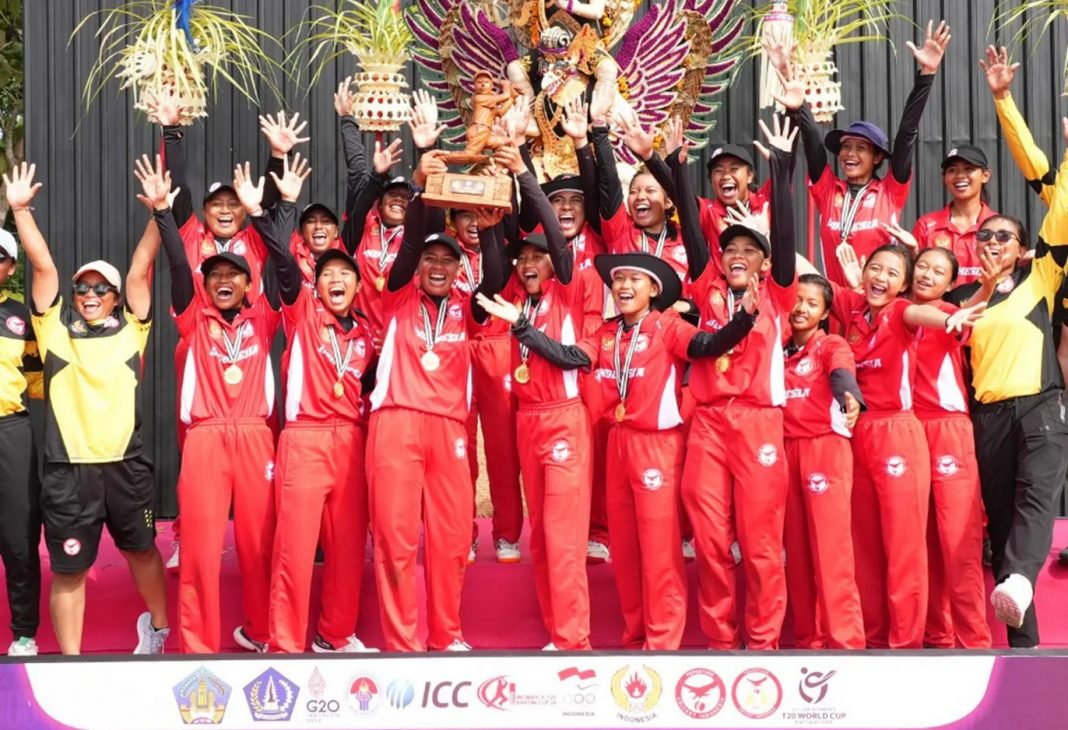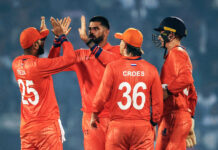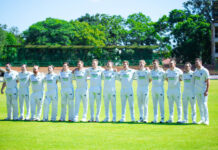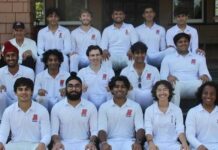This piece is about an associate nation with no Commonwealth link who is rapidly advancing their cricketing status primarily through their women’s teams – but I’m not talking about Thailand.
While the Thai women waltzed their way to three gold medals at the 2023 Southeast Asian (SEA) Games, the country that won silver twice to them was Indonesia (who also won gold in the Sixes format, though Thailand didn’t compete there). There may still have been a clear gulf between the two teams, but Indonesia’s women have certainly become a force in the region.
Indonesia’s national women’s team program didn’t start until 2016, nine years after Thailand and five after their male counterparts. It didn’t take long for them to get going, though, leapfrogging neighbours Malaysia and Singapore in the 2017 SEA Games and finishing fourth in the 2019 Thailand T20 Smash out of ten teams behind Thailand, Nepal, and the UAE.
However, their T20 World Cup aspirations were dashed in that year’s EAP qualifiers, finishing fourth out of six behind PNG, Samoa, and Vanuatu, to whom they lost convincingly. Four years on, on the eve of another round of EAP qualifiers, Indonesia are eager to show how far they’ve come.
The provincial pipeline
Emerging Cricket has previously discussed the various initiatives taken by Persatuan Cricket Indonesia (PCI, Indonesian Cricket Association) with chair Abhiram Singh Yadav back in 2018. Building on these recruitment pathways, Yadav credits the funnelling of players into the national team pipeline in large part to the nation’s network of provincial associations.
At the time of writing, there are cricket associations representing 20 of Indonesia’s 38 provinces. Representative teams from these provinces compete in annual national championships and the Pekan Olahraga Nasional (PON, National Sports Week) in which cricket was first included in 2016.
“We’re lucky to have the PON games, which is the national multisport games in Indonesia, where every province has the need to maintain their players and to make their province become a competitive team.”
“Between the provinces themselves, it’s a competitive place, and they have to keep on looking for more athletes by doing socialisation and developments throughout the regions in their province. This is the foundation.”
“[The national team] is also very competitive, so nobody is secure and everybody always has a chance to be there. And I think with the combination of the interest of the provincial governments and our interest from the PCI it matches, so cricket isn’t only a sport that has a team, but it has a wide development.”
“Apart from PON, every year we have a national championships which all provinces send their teams. There is a national championships for seniors as well as juniors.”
The national championships and PON also helps management to build a competitive longlist, which according to Yadav, “makes the team stronger and stronger.”
The inclusion of cricket in PON unlocks crucial funding from provincial governments, who also provide salaries to their players – enough so that players with both provincial and national contracts are able to be full-time cricketers. Having this group of 15 players who can dedicate all their time to cricket has allowed PCI to put them up in the same house in Bali for the past 1.5 years to foster team unity (the Thai team has also done something similar).
Yadav asserts that this development will be the difference between their underperformance in the 2019 EAP qualifiers and potentially advancing from the upcoming edition.
“In the past, we have [held the national camp] for two months, now we have done it for one and a half years.”
“With their matureness and their experience, our target is to qualify for the World Cup.”
Recent and upcoming tournaments
Improving with the bat is also crucial if Indonesia is to advance from the regional qualifiers, though there are positive signs with Indonesia’s runs scored per 20 overs in T20Is rising from 119.3 before 2022 to 137.7 after.
“With their matureness and their experience, our target is to qualify for the World Cup.”
Another sign of Indonesia’s progress and one that is directly comparable with an EAP rival is their U-19s team’s qualification over PNG’s to the inaugural Women’s U19 World Cup in South Africa, where they also went on to score a shock win against full member Zimbabwe.
“It was very valuable [to qualify for the U19 World Cup] … in fact, the seniors [players] look at the juniors as role-models!”
“We played against full members in the World Cup and we played all 20 overs without being all out [in all matches], so it was a big achievement.”
“The senior women are now looking forward to qualify for the World Cup as well.”
Since the World Cup, several U19 players have been promoted to the senior team, including captain Wesika Ratna Dewi. Having impressed with both bat and ball in South Africa, Wesika was given the responsibility of opening in both disciplines during the following SEA Games. She experienced some growing pains with the bat in her first forays with the seniors, but the faith shown in her and her former U19 teammates’ abilities so early speaks volumes of the quality of players pushing for senior team call-ups.
Two weeks after the T20 World Cup qualifiers, the team flies to Hangzhou, China to compete in the Asian Games. A loss in their first match would see them immediately eliminated in the tournament’s unforgiving format, but a win would see them rewarded with a match against one of India, Pakistan, Bangladesh, or Sri Lanka.
As Yadav puts it: “It’s our chance to show that we can do our magic, that we can play against gods”.
Finishing on top of the EAP regional qualifiers would afford Indonesia a place in the global qualifiers, where the likes of Sri Lanka and Ireland await. The opportunity is clear – play some good cricket over the next few weeks and Indonesia can catapult themselves into a whole different level of the game.
Looking ahead
Regardless of results in the EAP qualifiers and the Asian Games, the calibre of Indonesia’s opponents has expanded with the nation’s acceptance into the Asian Cricket Council’s (ACC) pathway tournaments as of February this year. This means participation in 2024’s ACC’s T20 Premier Cup, which allows them to qualify for either the Asia Cup or the Emerging Teams Asia Cup, not to mention tournaments for the age-group teams. Next year also sees the team attempt to qualify for the 2025 50 Over World Cup, while the U19s aim to qualify for back-to-back World Cups.
Off the field, PCI endeavours to retain players after their playing careers by making it mandatory for them to attend either coaching, umpiring, or curating workshops (the latter a step in fulfilling the dream of producing local turf pitches).
They also aim to organise competitive cricket for their national sides (across men’s and women’s teams, age groups, and across their Jakarta and Bali venues) so that cricket is played year-round in Indonesia. This is particularly important when preparing for tournaments though unfortunately, the series to prepare for the EAP qualifiers and Asian Games involving Kenya and Qatar had to be cancelled due to Kenya’s inability to obtain flights to Indonesia.
Ultimately, the Indonesian national women’s team wishes to consistently qualify for World Cups and to be a top 10 team in both the 20- and 50-over formats. There is a long way between now and then, but to achieve that goal, the next 12 months must play a vital role in them getting there.
You’re reading Emerging Cricket — brought to you by a passionate group of volunteers with a vision for cricket to be a truly global sport, and a mission to inspire passion to grow the game.
Be sure to check out our homepage for all the latest news, please subscribe for regular updates, and follow EC on Twitter, Facebook, LinkedIn and YouTube.
Don’t know where to start? Check out our features list, country profiles, and subscribe to our podcast.
Support us from US$2 a month — and get exclusive benefits, by becoming an EC Patron.







